Tuktoyaktuk
| Tuktoyaktuk Tuktuyaaqtuuq formerly Port Brabant | |
|---|---|
| Hamlet | |
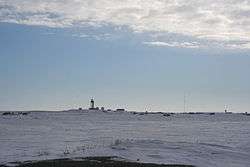 DEW line radar station at Tuktoyaktuk | |
| Nickname(s): Tuk | |
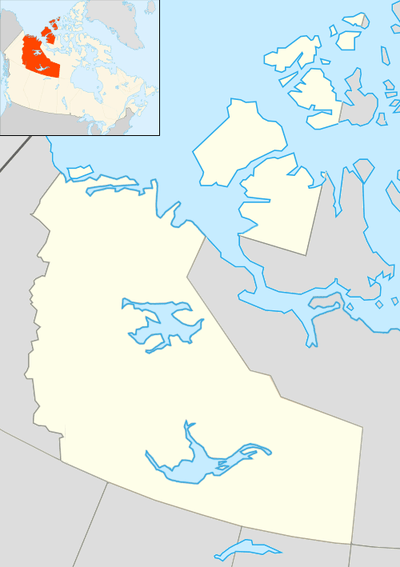 Tuktoyaktuk 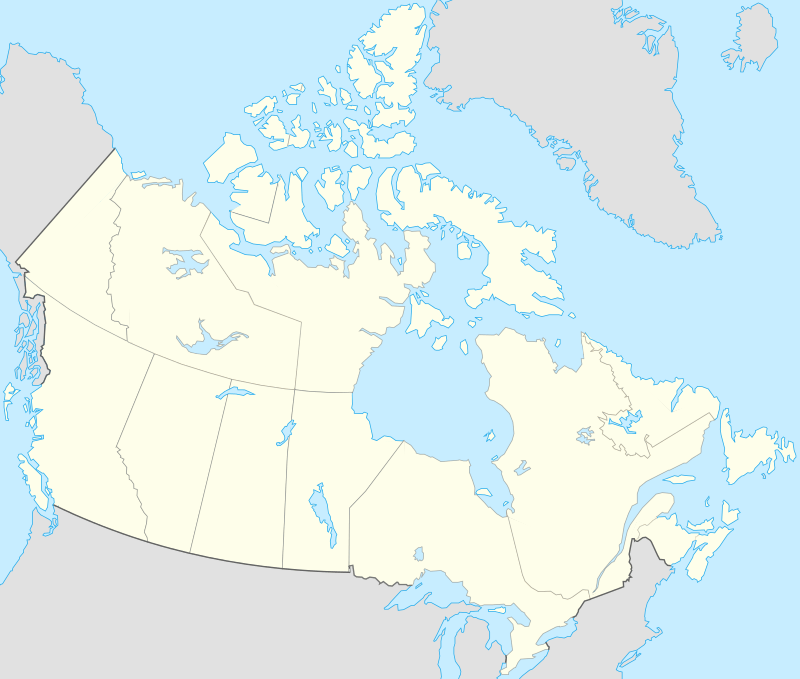 Tuktoyaktuk | |
| Coordinates: 69°26′34″N 133°01′52″W / 69.44278°N 133.03111°WCoordinates: 69°26′34″N 133°01′52″W / 69.44278°N 133.03111°W | |
| Country | Canada |
| Territory | Northwest Territories |
| Region | Inuvik Region |
| Electoral district | Nunakput |
| Census division | Region 1 |
| Settled | 1928 |
| Incorporated | 1 April 1970 |
| Government | |
| • Mayor | Merven Gruben |
| • Senior Administrative Officer | Duncan Walker |
| • MLA | Herbert Nakimayak |
| • Member of Parliament | Michael McLeod |
| • Senator | Nick Sibbeston |
| Area[1] | |
| • Land | 14.00 km2 (5.41 sq mi) |
| Elevation[2] | 5 m (15 ft) |
| Population (2016)[1] | |
| • Total | 898 |
| • Density | 64.1/km2 (166/sq mi) |
| Time zone | UTC-7 (MST) |
| • Summer (DST) | UTC-6 (MDT) |
| Canadian Postal code | X0E 1C0 |
| Area code(s) | 867 |
| Telephone exchange | 977 |
| - Living cost | 162.5A |
| - Food price index | 162.0B |
| Website | http://www.tuktoyaktuk.ca |
|
Sources: Department of Municipal and Community Affairs,[3] Prince of Wales Northern Heritage Centre,[4] Canada Flight Supplement[2] Northwestel[5] Natural Resources Canada[6] ^A 2013 figure based on Edmonton = 100[7] ^B 2015 figure based on Yellowknife = 100[7] | |
Tuktoyaktuk English: /tʌktəˈjæktʌk/, or Tuktuyaaqtuuq IPA: [təktujaːqtuːq] (Inuvialuktun: it looks like a caribou),[4] is an Inuvialuit hamlet located in the Inuvik Region of the Northwest Territories, Canada, at the northern terminus of the Inuvik–Tuktoyaktuk Highway.[8][9] Commonly referred to simply by its first syllable, Tuk /tʌk/, the settlement lies north of the Arctic Circle on the shores of the Arctic Ocean, and is the only community in Canada on the Arctic Ocean that is connected to the rest of Canada by road.[8] Formerly known as Port Brabant, the community was renamed in 1950 and was the first place in Canada to revert to the traditional Indigenous name.[10]
History
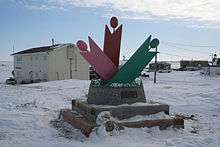
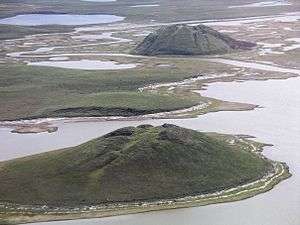
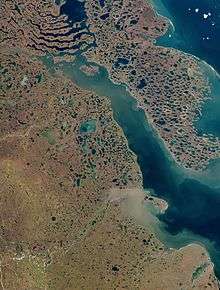
Tuktoyaktuk is the anglicized form of the native Inuvialuit place-name, meaning "resembling a caribou". According to legend, a woman looked on as some caribou, common at the site, waded into the water and turned into stone, or became petrified. Today, reefs resembling these petrified caribou are said to be visible at low tide along the shore of the town.[11]
No formal archaeological sites exist today, but the settlement has been used by the native Inuvialuit for centuries as a place to harvest caribou and beluga whales. In addition, Tuktoyaktuk's natural harbour was historically used as a means to transport supplies to other Inuvialuit settlements.
Between 1890 and 1910, a sizeable number of Tuktoyaktuk's native families were wiped out in flu epidemics brought in by American whalers. In subsequent years, the Dene people, as well as residents of Herschel Island, settled here. By 1937, a Hudson's Bay Company had established a trading post.
Radar domes were installed beginning in the 1950s as part of the Distant Early Warning Line, to monitor air traffic and detect possible Soviet intrusions during the Cold War. The settlement's location (and harbour) made Tuk important in resupplying the civilian contractors and Air Force personnel along the DEW Line. In 1947, Tuktoyaktuk became the site of one of the first government day schools designed to integrate Inuit youth into mainstream Canadian culture.[12]
The community of Tuktoyaktuk eventually became a base for the oil and natural gas exploration of the Beaufort Sea. Large industrial buildings remain from the busy period following the Organization of Arab Petroleum Exporting Countries 1973 oil embargo and 1979 summertime fuel shortage. This brought many more outsiders into the region.
On 3 September 1995, the Molson Brewing Company arranged for several popular rock bands to give a concert in Tuktoyaktuk as a publicity stunt promoting their new ice-brewed beer. During the months leading up to concert, radio stations across North America ran contests in which they gave away free tickets. Dubbed The Molson Ice Polar Beach Party, it featured Hole, Metallica, Moist, Cake and Veruca Salt. Canadian film-maker Albert Nerenberg made a documentary about this concert entitled Invasion of the Beer People.[13]
In late 2010, the Canadian Environmental Assessment Agency announced that an environmental study would be undertaken on a proposed all-weather road between Inuvik and Tuktoyaktuk.[14] Work on the Inuvik–Tuktoyaktuk Highway officially started on 8 January 2014, and the highway was officially opened on 15 November 2017.[8]
Geography
Tuktoyaktuk is set on Kugmallit Bay, near the Mackenzie River Delta, and is located on the Arctic tree line.
Tuktoyaktuk is the gateway for exploring Pingo National Landmark, an area protecting eight nearby pingos in a region which contains approximately 1,350 of these Arctic ice-dome hills. The landmark comprises an area roughly 16 km2 (6.2 sq mi), just a few miles west of the community, and includes Canada's highest (the world's second-highest) pingo, at 49 m (161 ft).[15]
Employment
Many locals still hunt, fish, and trap. Locals rely on caribou in the autumn, ducks and geese in both spring and autumn, and fishing year-round. Other activities include collecting driftwood, berrypicking and reindeer herding. Most wages today, however, come from tourism and transportation. Northern Transportation Company Limited (NTCL) is a major employer in this region. In addition, the oil and gas industry continues to employ explorers and other workers.
Demographics

At the 2016 Census, the Hamlet of Tuktoyaktuk had a population of 898, up 5.2% from the 2011 census total of 854. There are 283 private dwellings, and a population density of 64.1 inhabitants per square kilometre (166/sq mi).The average annual personal income in 2015 was $21,984 Canadian and the average family income was $55,424. Local languages are Inuinnaqtun (Inuvialuktun) and English with a few North Slavey and Tłı̨chǫ (Dogrib) speakers. Tuktoyaktuk is predominately Indigenous (90.8%) with Inuit (Inuvialuit) making up 88.0%, 9.2% non-Aboriginal, 1.7% First Nations and 1.1% giving multiple Indigenous backgrounds.[1]
In 2017 the Government of the Northwest Territories reported that the population was 1,026 with an average yearly growth rate of 1.3 from 2007.[7]
| Historical population | |||||||||||||||||||||||||||||||||||||||||||||||||||||||||||||||||||||||||
|---|---|---|---|---|---|---|---|---|---|---|---|---|---|---|---|---|---|---|---|---|---|---|---|---|---|---|---|---|---|---|---|---|---|---|---|---|---|---|---|---|---|---|---|---|---|---|---|---|---|---|---|---|---|---|---|---|---|---|---|---|---|---|---|---|---|---|---|---|---|---|---|---|---|
|
| ||||||||||||||||||||||||||||||||||||||||||||||||||||||||||||||||||||||||
| Sources: NWT Bureau of Statistics (2001–2017)[16] | |||||||||||||||||||||||||||||||||||||||||||||||||||||||||||||||||||||||||
Climate
Tuktoyaktuk displays a subarctic climate, just short of a polar (tundra) climate, as the July mean temperature is barely above 10 °C (50 °F).
| Climate data for Tuktoyaktuk/James Gruben Airport | |||||||||||||
|---|---|---|---|---|---|---|---|---|---|---|---|---|---|
| Month | Jan | Feb | Mar | Apr | May | Jun | Jul | Aug | Sep | Oct | Nov | Dec | Year |
| Record high humidex | 3.8 | 0.7 | −0.5 | 6.4 | 23.3 | 29.6 | 34.1 | 32.9 | 21.6 | 16.4 | 2.1 | 0.6 | 34.1 |
| Record high °C (°F) | 0.6 (33.1) |
0.7 (33.3) |
−0.5 (31.1) |
4.8 (40.6) |
20.9 (69.6) |
28.2 (82.8) |
29.4 (84.9) |
27.6 (81.7) |
20.9 (69.6) |
17.4 (63.3) |
2.2 (36) |
0.8 (33.4) |
29.4 (84.9) |
| Average high °C (°F) | −23.0 (−9.4) |
−22.4 (−8.3) |
−21.1 (−6) |
−11.3 (11.7) |
−1.1 (30) |
11.0 (51.8) |
15.1 (59.2) |
12.3 (54.1) |
5.8 (42.4) |
−4.7 (23.5) |
−17.3 (0.9) |
−20.1 (−4.2) |
−6.4 (20.5) |
| Daily mean °C (°F) | −26.6 (−15.9) |
−26.4 (−15.5) |
−25.1 (−13.2) |
−15.7 (3.7) |
−4.7 (23.5) |
6.4 (43.5) |
11.0 (51.8) |
8.9 (48) |
3.3 (37.9) |
−7.4 (18.7) |
−20.7 (−5.3) |
−23.8 (−10.8) |
−10.1 (13.8) |
| Average low °C (°F) | −30.4 (−22.7) |
−30.6 (−23.1) |
−29.2 (−20.6) |
−20.1 (−4.2) |
−8.2 (17.2) |
1.7 (35.1) |
6.9 (44.4) |
5.4 (41.7) |
0.7 (33.3) |
−9.9 (14.2) |
−24.0 (−11.2) |
−27.5 (−17.5) |
−13.8 (7.2) |
| Record low °C (°F) | −48.9 (−56) |
−46.6 (−51.9) |
−45.5 (−49.9) |
−42.8 (−45) |
−28.9 (−20) |
−8.9 (16) |
−1.7 (28.9) |
−2.5 (27.5) |
−12.8 (9) |
−28.5 (−19.3) |
−40.1 (−40.2) |
−46.7 (−52.1) |
−48.9 (−56) |
| Record low wind chill | −70.8 | −61.2 | −58.1 | −55.5 | −40.1 | −16.5 | −6.5 | −8.9 | −20.9 | −46.9 | −50.8 | −58.9 | −70.8 |
| Average precipitation mm (inches) | 10.5 (0.413) |
8.9 (0.35) |
7.2 (0.283) |
8.3 (0.327) |
6.8 (0.268) |
11.0 (0.433) |
22.3 (0.878) |
25.7 (1.012) |
23.3 (0.917) |
18.4 (0.724) |
9.6 (0.378) |
8.7 (0.343) |
160.7 (6.327) |
| Average rainfall mm (inches) | 0.0 (0) |
0.0 (0) |
0.0 (0) |
0.0 (0) |
1.4 (0.055) |
9.7 (0.382) |
22.2 (0.874) |
24.4 (0.961) |
15.5 (0.61) |
1.3 (0.051) |
0.0 (0) |
0.3 (0.012) |
74.9 (2.949) |
| Average snowfall cm (inches) | 13.4 (5.28) |
10.2 (4.02) |
9.0 (3.54) |
9.4 (3.7) |
6.2 (2.44) |
1.3 (0.51) |
0.1 (0.04) |
1.2 (0.47) |
8.9 (3.5) |
20.1 (7.91) |
12.1 (4.76) |
11.2 (4.41) |
103.1 (40.59) |
| Average precipitation days (≥ 0.2 mm) | 8.4 | 7.3 | 7.1 | 5.5 | 4.9 | 5.1 | 10.1 | 12.7 | 12.7 | 13.3 | 9.6 | 8.9 | 105.6 |
| Average rainy days (≥ 0.2 mm) | 0.1 | 0.1 | 0.0 | 0.0 | 1.1 | 4.3 | 10.0 | 12.4 | 9.0 | 1.1 | 0.0 | 0.1 | 38.1 |
| Average snowy days (≥ 0.2 cm) | 8.6 | 7.4 | 7.5 | 5.8 | 4.2 | 1.0 | 0.1 | 0.9 | 5.0 | 13.0 | 9.9 | 9.1 | 72.5 |
| Average relative humidity (%) | 74.2 | 73.0 | 73.9 | 81.5 | 81.5 | 68.4 | 68.7 | 73.9 | 77.9 | 85.7 | 79.5 | 76.1 | 76.2 |
| Source: Environment Canada Canadian Climate Normals 1981–2010[17] | |||||||||||||
Transportation
Tuktoyaktuk/James Gruben Airport links Tuktoyaktuk to Inuvik. This 30-minute flight costs a few hundred dollars per passenger. Formerly in winter time, the Tuktoyaktuk Winter Road provided road access to Inuvik. The $300-million Inuvik–Tuktoyaktuk Highway opened in November 2017,[18][8] which provides all-season access to Inuvik, which connects to the rest of the highway networks in Canada.[19]
In popular culture
- In the third episode of Jesse James Is a Dead Man, Jesse James drove from Inuvik to Tuktoyaktuk to drop off medical supplies, on his motorcycle. Originally Aired on June 14th, 2009 on Spike Tv (Now Paramount Network). [20]
- Mentioned often as familiar territory to Benton Fraser in the TV show Due South. At one point, Ray Vecchio, Fraser's partner, confuses the name of this real town with a fictitious town he calls "runamokluk".
- Is referenced numerous times in the Stompin' Tom Connors song, "Mukluk Shoe".
- Is mentioned briefly in the song "Canadian Girls" by Dean Brody.
- Is the subject of the song "Time Before Bones" by Dana Sipos's winning song from CBC Radio 2's 2009 Great Canadian Song Quest competition.
See also
References
- 1 2 3 "Census Profile, 2016 Census Tuktoyaktuk, Hamlet [Census subdivision], Northwest Territories and Northwest Territories [Territory]". 2016 Census. Statistics Canada.
- 1 2 Canada Flight Supplement. Effective 0901Z 19 July 2018 to 0901Z 13 September 2018.
- ↑ "NWT Communities - Tuktoyaktuk". Government of the Northwest Territories: Department of Municipal and Community Affairs. Retrieved 2014-01-16.
- 1 2 "Prince of Wales Northern Heritage Centre - official names" (PDF). Retrieved 2011-12-27.
- ↑ Northwestel 2008 phone directory
- ↑ Canadian Geographical Names Database - Native names for Native places Archived 1 October 2006 at Archive.is
- 1 2 3 Tuktoyaktuk - Statistical Profile at the GNWT
- 1 2 3 4 Montgomery, Marc. "Canada now officially connected by road-coast to coast to coast", CBC Radio, 15 November 2017. Retrieved on 15 November 2017.
- ↑ Lamb, David. "Driving to the top of the world: Exploring Canada's new Arctic highway", CBC, 18 April 2017. Retrieved on 15 November 2017.
- ↑ "Infofile Detail - Native Names for Native Places". Edmonton Public Library. Archived from the original on 30 July 2013. Retrieved 12 December 2012.
- ↑ "Tourist guide". Tuk.ca. Retrieved 2011-12-27.
- ↑ Keith J. Crowe, A History of the Original Peoples of Northern Canada, Arctic Institute of North America, McGill-Queen's University Press, Montreal and London - 1974. ISBN 0-7735-0220-3
- ↑ "Website for Invasion of the Beer People". Nutaaq.com. Retrieved 2011-12-27.
- ↑ "Canadian Environmental Assessment Registry - Environmental Assessment Home Page". Ceaa.gc.ca. 2010-09-27. Retrieved 2011-12-27.
- ↑ Parks Canada (2005). "Pingo National Landmark". Archived from the original on 3 June 2007. Retrieved 5 January 2008.
- ↑ Population Estimates By Community from the GNWT
- ↑ "Tuktoyaktuk A" (CSV (3069 KB)). Canadian Climate Normals 1981–2010. Environment Canada. Climate ID: 2203912. Retrieved 2014-01-09.
- ↑ "Official Opening Ceremonies". Inuvik Tuktoyaktuk Highway. Government of Northwest Territories. Retrieved 24 October 2017.
- ↑ Stewart, Brian (2017-10-23). "New Arctic coast highway opens up remote Tuktoyaktuk". CBC News.
- ↑ https://www.imdb.com/title/tt1436160/?ref_=tt_cl_i1
External links
| Wikimedia Commons has media related to Tuktoyaktuk. |